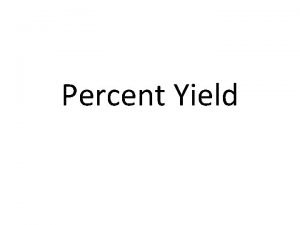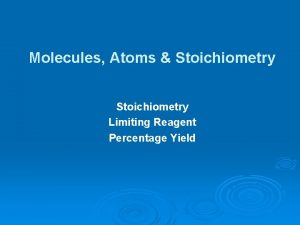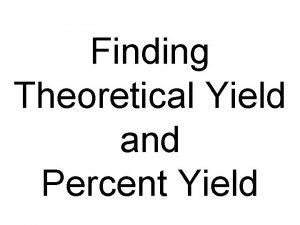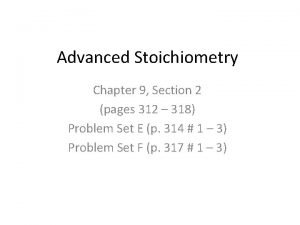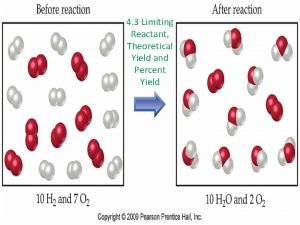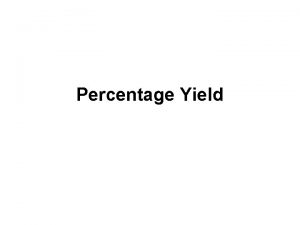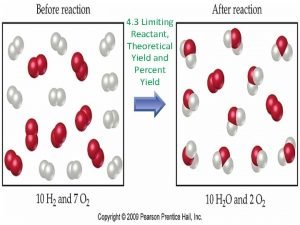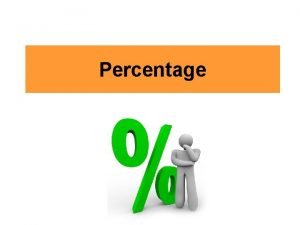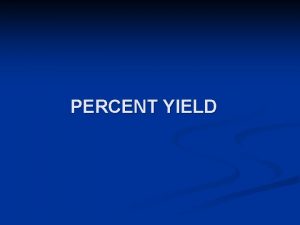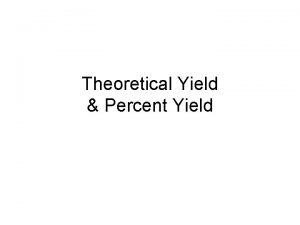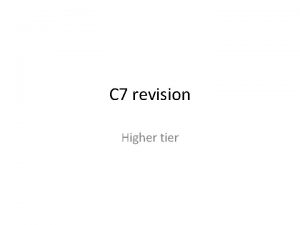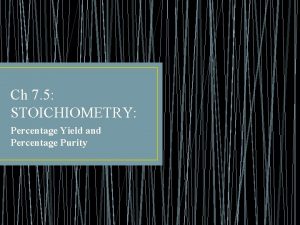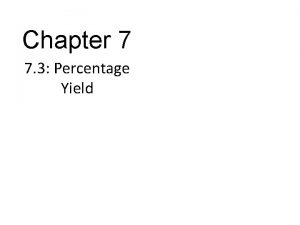Percentage Yield What is Yield Its the amount










- Slides: 10

Percentage Yield

What is Yield? It’s the amount of product that is produced in a chemical reaction actual yield. What you get in a chemical reaction may not be what you were supposed to get. The theoretical yield tells you how much product you should get according to the balanced equation.

Factors affecting Yield • • • Splattering when heating a solution Filtering may not get all of the product Using impure/contaminated reactants Not letting wet solids dry properly Use of equipment (old or faulty) Side chemical reactions (eg. When you burn Mg in the air. It reacts with O 2. However, air also has nitrogen, so Mg may react with N 2 too!)

Percentage Yield The comparison between the actual yield and theoretical yield of a product in a reaction. Percentage yield = Actual Yield x 100% Theoretical Yield

Example 1 Zinc reacts with hydrochloric acid to produce zinc chloride and hydrogen gas, as seen below: Zn (s) + 2 HCl (aq) → Zn. Cl 2 (aq) + H 2 (g) Calculate theoretical yield and percentage yield of Zn. Cl 2 if 1. 541 g of Zn. Cl 2 (aq) is produced when 0. 999 g of HCl (aq) is used.

Balanced Eq’n Zn (s) + Given Mass (g) 2 HCl (aq) → Zn. Cl 2 (aq) + 0. 999 g 1. 541 g (actual) Molar Mass (g/mol) 36. 46 g/mol 136. 29 g/mol 1. Find # moles reactant n. HCl = 0. 999 g 36. 46 g/mol = 0. 0274 mol 2. Find # moles of product, using mole ratio 1 mol Zn. Cl 2 n. Zn. Cl 2 = 0. 0274 mol HCl x _____ = 0. 0137 mol 2 mol HCl H 2 (g)

3. Find mass of product m. Zn. Cl 2 = n x M = 0. 0137 mol x 136. 29 g/mol = 1. 86 g theoretical yield 4. Calculate % yield = actual yield x 100% theoretical yield = 1. 541 g x 100% 1. 86 g = 82. 8%

Example 2 In an experiment, 16. 1 g of iron sulfide, Fe. S (s), is added to oxygen. 14. 1 g of iron(III) oxide, Fe 2 O 3 (s) is produced. Calculate theoretical yield and percentage yield of Fe 2 O 3 (s). 4 Fe. S (s) + 7 O 2 (g) → 2 Fe 2 O 3 (s) + 4 SO 2 (g)

Balanced Eq’n 4 Fe. S (s) + Given Mass (g) 16. 1 g Molar Mass (g/mol) 87. 92 g/mol 7 O 2 (g) 2 Fe 2 O 3 (s) + → 14. 1 g (actual) 159. 7 g/mol 1. Find # moles reactant n. Fe. S = 16. 1 g 87. 92 g/mol = 0. 183 mol 2. Find # moles of product, using mole ratio 2 mol Fe 2 O 3 n. Fe 2 O 3 = 0. 183 mol Fe. S x _____ = 0. 0915 mol 4 mol Fe. S 4 SO 2 (g)

3. Find mass of product m. Fe 2 O 3 = n x M = 0. 0915 mol x 159. 7 g/mol = 14. 61 g theoretical yield 4. Calculate % yield = actual yield x 100% theoretical yield = 14. 1 g x 100% 14. 61 g = 96. 5%
 What is theoretical yeild
What is theoretical yeild Efficiency of chemical reaction
Efficiency of chemical reaction Calculate percentage yield
Calculate percentage yield Percentage yield
Percentage yield How to calculate percent yield
How to calculate percent yield Percentage yield
Percentage yield How to calculate percentage yield in organic chemistry
How to calculate percentage yield in organic chemistry Difference between actual yield and theoretical yield
Difference between actual yield and theoretical yield Percentage yield
Percentage yield How to find percentage yeild
How to find percentage yeild Limiting reactant
Limiting reactant

